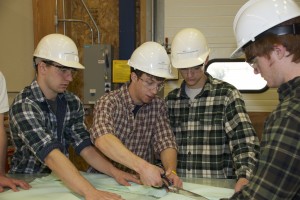
Students manufacturing their blades at the Advanced Structures & Composites Center at the University of Maine.
Maine Wind Blade Challenge 2018!
When: Friday, May 18th, 2018
Where: The University of Maine Orono, Advanced Structures and Composites Center
35 Flagstaff Rd. Orono, ME
Click here to register your teams!
Maine high school teams compete each year to create an energy-producing set of wind blades in the annual Wind Blade Challenge. Produced through hands-on science and engineering course work, students design, infuse, manufacture and test blades, going up against other students from around the state during the one-day challenge. Educators and manufacturers collaborate on this successful and growing STEM (science, technology, engineering, and math) challenge, hosted by UMaine each year, raising career aspirations for students and developing a workforce for Maine’s growing composites industry.
Details:
– Students form teams (recommended no more than 4 students per team) and work together to design and construct their model wind blades. Resources will be offered to guide students and teachers in the process, including suggestions on materials and techniques from industry professionals, and past teams.
– Upon registration, teachers will receive a registration form to be filled out and returned, an electronic form of the Guidebook, and photo release forms required for the day of the competition.
– Materials are mailed to the address provided.
– Connections with a regional composites manufacturer are made for teachers between February and April.
– On competition day, teams will travel to the University of Maine’s Advanced Structures and Composites Center where they will test their blades, and present their experience to a panel of judges.
– Winners will be awarded a work study opportunity in the Advanced Structures and Composites Center valued at $20,000!
Kits are supplied by the Maine Composites Alliance, containing 3 blocks of polyisocyanurate foam, one sheet of fiberglass, and the competition guidelines. Teams of students design a set of wind blades through research and experimentation with methods of their choice. They are then required to use the Vacuum Infusion Process to finish their blades on-site in a composites lab.
Teams will test their blades integrity and ability to produce electricity during the competition. Students must also prepare a presentation that addresses technical design and engineering process.
Judges with both industry and academic backgrounds score entries on design criteria, energy generated and presentation content/delivery to choose the winning Challenge team.
Please see the links below to download a copy:
2018 WBC Guidebook
WBC Presentation Score Sheet
Photo Release Form
Webinar presentations/notes
Criteria for judging is based on the Maine Department of Educations Science & Technology Standards:
Students use a systematic process, tools and techniques, and a variety of materials to design and produce a solution or product that meets new needs or improves existing designs.
a. Identify new problems or a current design in need of improvement.
b. Generate alternative design solutions.
c. Select the design that best meets established criteria.
d. Use models and simulations as prototypes in the design planning process.
e. Implement the proposed design solution.
f. Evaluate the solution to a design problem and the consequences of that solution.
g. Present the problem, design process, and solution to a design problem including models, diagrams, and demonstrations.
